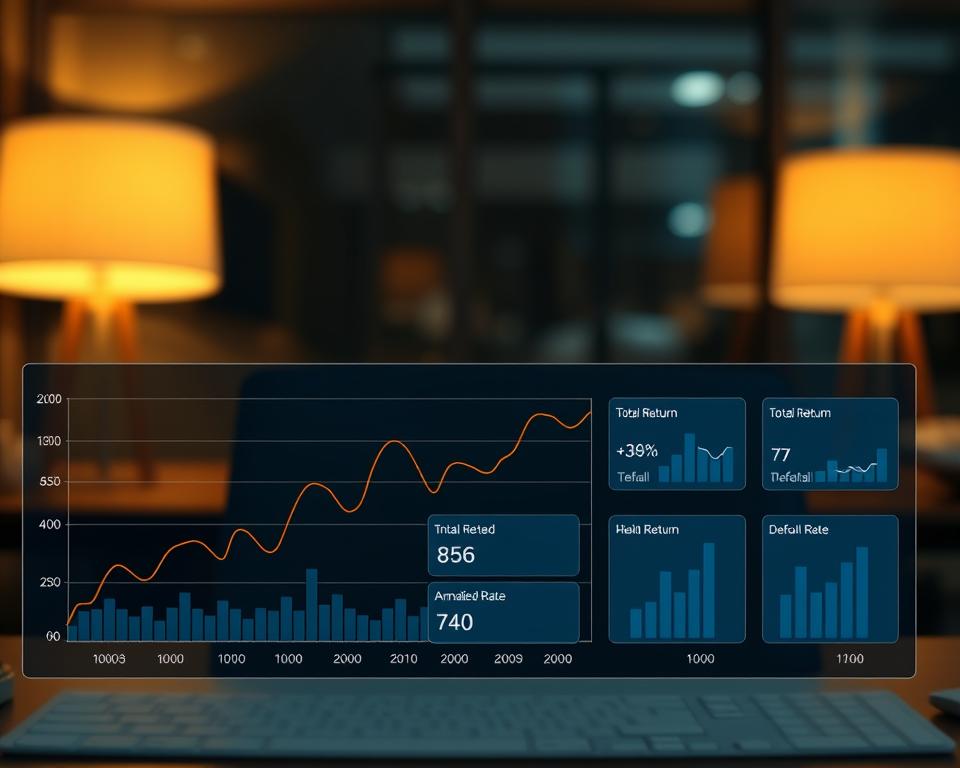Monitor Your CLO Equity Performance Effectively
Were you aware that CLOs in the U.S. have expanded into an immense $1.1 trillion industry? Such expansion isn’t just about numbers. It mirrors the capital market’s intricacy and CLO equity’s budding role for investors such as big pension schemes and private wealth offices. The emergence of advanced stakeholders in CLOs underscores the significance of dominating CLO equity performance monitoring.
Investing in CLO capital investments offers numerous advantages, appealing to a broad spectrum of stakeholders. The possibility of significant gains and steady cash disbursements render CLO funds a valuable addition to diverse portfolios. This unique value proposition highlights their appeal. Investors are enthralled by CLO equity on account of its high return potential, regularly pursuing mid-teens returns, similar to those sought in private equity. This appeal persists, despite shifting interest rates and economic shifts. CLOs, with their 150 to 200 assorted positions, offer a level of security uncommon in more focused portfolios. I intend to supply you with the essential indicators and perspectives for index CLO performance, assisting in making savvy investment decisions.
Grasping CLOs: A Comprehensive Overview
Collateralized loan obligations (CLOs) are complex monetary instruments. They bundle multiple leveraged loans, dividing them to investors. Understanding CLOs is vital as they offer business funding options. Across 35+ years, their progress has dramatically altered investment strategies for organizations. The following segment provides insight into the CLO market’s historical evolution and current trends. It spotlights crucial trends and features shaping investors.
What is a CLO?
CLOs present a innovative technique for processing leveraged loans. They combine over 200 below-investment-grade, well-secured corporate loans. This approach minimizes risk while generating enticing returns. The U.S. CLO market has been flourishing, now toppling $1 trillion as of March 2024. Since 2012, it’s grown roughly 10% yearly. Even with a growth deceleration to roughly 6% in 2023, a small decrease to 1% is foreseen in early 2024. Significantly, the prime segments, AAA and AA, have never defaulted, highlighting CLOs’ stability.
Growth and Evolution of CLOs over the Years
The journey of CLOs is notably marked by their robustness in the face of economic downturns. The recent financial upheaval proved this robustness; CLOs preserved a solid credit profile with minimal default rates, in contrast to corporate bonds. Following a decline to $263 billion in the post-crisis period, the market recovered impressively. By September 2023, it soared to $970 billion. This expansion showcases their reliability in today’s CLO market environment.
Innovative methods, like CLO ETFs, have boosted the market additional progress. It’s now estimated at $15 billion, thanks to enhanced market activity and liquidity. In the America, a new CLO deal typically averages $500 million. In Europe, deals are somewhat smaller, usually €400 million. The majority, sixty to sixty-five percent, goes to senior tiers. The equity segment make up about 9%-10%.
From grasping CLO basics to understanding their progress and current trends, it’s clear they’re vital in capital markets. They exceptionally balance risk against return for stakeholders.
The Attractiveness of CLO Share Investments
Investing in CLO capital investments offers many benefits, captivating a wide range of investors. The potential for high returns and steady cash disbursements makes CLO funds a valuable addition to varied portfolios. This unique value proposition highlights their attractiveness.
Main Perks for Investors
CLO equity is notable for its potential double-digit returns. Forecasts suggest returns of modest double-digit returns. Steady cash payouts add to the appeal of CLO investment funds, particularly for income-focused investors. Additionally, strong market fundamentals, such as minimal default rates, increase confidence in these investments.
Traditionally, CLO capital has recorded lower default rates than traditional debt instruments. Despite potential financial stress in certain segments, expected default rates should remain low. In times of recession, elevated loan spreads can benefit CLO investors. This allows for wise credit evaluation to reduce potential losses.
CLO Equity vs. Other Asset Classes
Evaluating CLO equity with other asset classes highlights its unique benefits. It offers higher liquidity than private equity investments without compromising yield. Although spread compression has occurred, CLOs offer superior yields than debt of similar ratings, demonstrating its allure.
| Asset Class | Returns | Default Rates | Marketability |
|---|---|---|---|
| CLO Shares | Low to Mid-Teens | Less than traditional debt | Moderate; not as liquid as Treasuries |
| Private Capital | Inconsistent; generally lower liquidity | Variable, depending on market phase | Minimal; usually not liquid |
| High Return Bonds | Above Treasury yields | Increased defaults relative to CLOs | High; more liquid |
The demand for CLOs remains strong, pointing to a favorable 2024 outlook. Competitive financing rates, thanks to a beneficial spread balance, boost this investment. For those maneuvering through the volatile market, an appreciation of CLO equity can be crucial for effective strategy development.

Tracking CLO Equity Performance: Measures and Mechanisms
For those intent on optimizing gains, accurate tracking of CLO equity performance is crucial in the complicated financial environment. Effective use of CLO key metrics greatly improves portfolio strategies. Comprehending essential performance indicators (KPIs), such as cash flow allocations, net asset value, and expense ratios is essential. They offer deep insights into the operational effectiveness of CLO holdings.
Essential KPIs for CLO Capital
CLO investors keep a close eye on multiple performance indicators to effectively measure performance. Notable indicators are:
- Internal Rate of Return (IRR): This metric is vital for assessing long-term profitability.
- Cash-on-Cash Return: Illuminates the comparison between cash disbursements and capital invested.
- Net Asset Value (NAV): Indicates the market value of a firm’s assets, vital for CLO appraisal.
- Payout Ratio: Usually approximates 50% of cash flows from assets.
- Failure Rates: Typically fall between 2% and 3%, with a mean 70% recovery for defaults.
Utilizing Tracking Tools Effectively
For successful management of CLO share investments, which comprise more than $600 billion globally, efficient tracking mechanisms are crucial. Companies like Flat Rock Global provide dedicated instruments for monitoring CLO equity performance. These mechanisms allow participants to effectively oversee their portfolios.
Such instruments aid in evaluating performance metric trends and setting benchmarks with indices like the J.P. Morgan CLO Index. They also simplify comparing with broader indices such as the Aggregate Bond Index by Bloomberg and the ICE BofA US Corporate Benchmark.
Making informed decisions to optimize CLO capital performance becomes achievable for investors leveraging these metrics and tools. This understanding and effective utilization lay the foundation for successful CLO management strategies.
Market Trends Influencing CLO Capital Performance
Examining the CLO private equity market trends needs a thorough analysis of the economic environment and its impact on investments. Growth statistics highlight a strong market, offering vital perspectives to stakeholders. By November 2024, U.S. CLO issuances hit $191 billion, a 72% increase compared to the previous year. This underlines an growing allure of CLOs amidst economic shifts.
Current Market Conditions
CLO volume has climbed to $465 billion, outdoing the peak in 2021 at $438 billion. October 2024 saw $59 billion, and November followed with $26 billion, the second-highest. The market increased by 1% from the start of the year, reaching a total of $1.046 trillion. Moreover, the surge in private credit CLOs with a $36 billion new issuance, broke records.
Influence of Interest Rates on CLO Share Performance
Rising interest rates critically affect CLO capital, mostly due to their floating-rate nature. This enhances the appeal of CLO investments for those seeking higher returns in a fluctuating market. Predictions suggest CLO issuances in 2025 could be between $180 billion and $215 billion, propelled by supportive elements. Watching the default rate, which improved from 3.3% in January 2024 to 3.1% at Q1’s end, is vital for CLO stakeholders. This evolving scene offers an opportunity to optimize portfolios amidst current CLO equity market movements.
Active Management Strategies for CLO Equity
Managing CLO equity investments requires an active approach. Via tactical market maneuvering, CLO equity managers aim to boost returns and mitigate risks. These managers understand the complexities of the market. This knowledge significantly influences the performance of stakeholders’ investments.
How Managers Drive Performance
CLO portfolio overseers are pivotal in enhancing portfolio performance. They monitor the credit quality and pricing of loans. With this data, they exploit market opportunities. Such attentiveness enables swift reactions to market changes, maximizing CLO equity distributions. The attractive default rates and low correlation with risk assets like the average US corporate 5-year cumulative default rate demonstrate CLOs’ attractiveness.
Risk Mitigation Techniques in CLO Management
CLO equity managers use varied techniques to protect against fiscal risks. These tactics are essential for safeguarding stakeholders during volatile market periods. They concentrate on the spread between asset returns and debt costs to enhance cash flow efficiency. The range of IRRs in CLO equity, with upper quartiles up to 25% and lower quartiles occasionally under 0%, underscore these mitigation strategies’ significance in preserving investment stability amid market fluctuations.
Importance of CLO Indices and Comparative Benchmarks
Grasping the function of the CLO index is crucial for making informed equity investment choices. It serves as an indicator for CLO performance, echoing market trends and affecting investor approaches. By examining these indices, we obtain detailed insights into CLO metrics. This facilitates effective comparison of risk and trend patterns among diverse asset classes.
Understanding CLO Index Performance
CLO market size has grown to a remarkable $1.2 trillion. It now satisfies about 70% of the demand for US corporate loans. Such growth emphasizes the necessity for dependable benchmarks. Here, CLO indices provide a pivotal function. They assess a broad spectrum of performance metrics, permitting investors to evaluate their holdings against the broader market.
Benchmarking Against Other Indices
Evaluating CLO performance in comparison to other indices sheds light on its positioning. CLO equity usually exhibits approximately a 90:10 debt-to-equity ratio. Concerning safety, AAA tranches record an almost non-existent default rate. This is in sharp contrast to the long-term average default rates of US corporations. Thus, CLOs are notable for their attractive yields and outstanding stability in fixed income.
Moreover, CLO performance metrics often point to a spread benefit over traditional bonds, notably in high-yield segments. This translates into higher potential gains for investors in addition to significant diversification benefits. CLOs show a lesser correlation with other high-yield bonds and equities, enabling smarter CLO market positioning and more insightful investment strategy development.
Challenges in Monitoring CLO Equity Performance
Monitoring CLO equity performance is notably challenging, particularly during turbulent market conditions. Investors encounter complexities due to market fluctuations that influence risk analysis and investment opportunities. These market oscillations can substantially influence default probabilities and purchasing decisions. Therefore, implementing robust strategies is critical to maintain optimal CLO performance.
Market Turbulence and Consequences
The outlook for the bond market suggests that fixed income stakeholders are transitioning to dynamic management techniques. This change aims to better adapt to ongoing market volatility, improving returns for fixed income portfolios. Currently, the credit cycle is evolving, not at its zenith, indicating sustained credit portfolio prospects up to 2025. Given elevated interest rates, CLO monitoring challenges are pronounced, increasing the capital burden for CLO equity and emphasizing careful management.
Understanding Default Risks in CLO Investments
It’s crucial to grasp the risk of default in CLO investments for accurate tracking. Evidence suggests that during economic downturns, CLO loan default rates could hit 3%, detrimentally influencing performance. The interaction of higher interest rates with lower returns further complicates various investment strategies. Remarkably, about 40% of CLO managers are employing advanced analytics and AI to enhance their monitoring, tackling transparency issues, and improving performance assessments. The complexity of the assets underneath and ongoing regulatory changes introduce additional challenges in managing CLO equity performance effectively.
Prospective Future for CLO Capital Investments
The environment of collateralized loan obligations (CLOs) is experiencing a metamorphosis. This development indicates a future for CLO equity investments defined by potential and complexity. Market trend analyses reveal significant prospects borne from shifts in supply, demand, and interest rates. A notable increase in 2024 issuances, reaching $199.8 billion signals a robust recovery. This figure is 72% higher than 2023’s and surpasses previous records, affirming the importance of CLO equity in investments.
Record-breaking refinancing and reset activities, reaching $309.1 billion in 2024, underscore investor confidence in CLOs. This reveals promising prospects, especially for those ready to steer through the changing market dynamics.
Prospective Advantages in Today’s Environment
With regulatory modifications like Basel III on the horizon, an injection of about $190 billion could strengthen the market. These regulatory shifts are designed to enhance the attractiveness of AAA, AA, and single-A CLO tranches, anticipated to trigger a demand surge. CLOs continue to offer attractive total returns, particularly among lower-rated categories. This illustrates their outstanding performance along with risk-adjusted gains.
Predicted Trends and Changes to Watch For
Several forecasted shifts in CLO investment merit consideration. The prospect of tighter spreads and enhanced liquidity emerges, shaping investment strategies. The historical resilience against defaults makes CLO equity a comparatively secure option in volatile markets. With strong new issuance expected in 2025, shrewd investors willing to update their approaches might reap notable returns amid evolving conditions. Investors should vigilantly monitor secondary equity positions for attractive cash-on-cash yields.
Final Thoughts
To sum up, effectively tracking CLO equity performance is crucial for investors entering this distinct asset class. Given that the present CLO market valuation surpasses $1.1 trillion, of which CLO equity represents roughly $100 billion, it’s clear. These investments offer strategic advantages not to be overlooked.
The significance of proactive management in elevating CLO performance during vital reinvestment intervals is paramount. Given the CLO market’s fluctuations—including interest rates, market conditions, and deal timings, it’s imperative for investors to stay informed and proactive. This approach ensures they can adapt strategies as necessary, maximizing CLO investment potentials.
For well-informed participants, diving into CLO equity opens up remarkable career possibilities. The combination of diversification advantages and potential for high yields demonstrates that CLO equity is an essential component of diversified portfolios. Looking ahead, maintaining awareness of market trends and proactive involvement in the CLO sector yields considerable benefits. This emphasizes the importance of a careful CLO investment approach.
FAQ
What is a CLO?
CLOs, also known as collateralized loan obligations, combine various leveraged loans. These are then sold in segments to investors, presenting a distinctive method for participating in corporate finance.
What are the main benefits of investing in CLO equity?
CLO equity investment offers notable benefits. Investors can anticipate high returns and regular payouts. Additionally, these investments have a low correlation with other asset classes. They also offer the chance for performance improvement through skilled management.
How do I track CLO equity performance?
Monitoring CLO equity involves concentrating on essential performance indicators such as cash flow distributions, net asset value, and expense ratios, with the aid of tracking tools provided by firms like Flat Rock Global.
How do market trends influence CLO equity performance?
Notable market trends such as changes in interest rates and economic conditions significantly affect CLO equity performance, often resulting in higher income when rates increase due to their floating nature.
How do CLO managers enhance equity returns?
CLO managers elevate equity returns by engaging in strategic trading, meticulous risk management, and by closely monitoring loan credit quality and pricing, adapting as the market evolves.
What is the significance of CLO indices in performance evaluation?
CLO indices serve as essential benchmarks that allow investors to gauge CLO equity performance relative to the broader market, thereby illuminating risk and return profiles.
What challenges might investors face when monitoring CLO equity performance?
Investors may encounter difficulties such as market volatility affecting default risk evaluations and timing of investments, necessitating constant monitoring of underlying assets.
How is the future for CLO equity investments expected to unfold?
CLO equity investments are forecasted to have a favorable future, with a shifting market landscape and expected interest rate adjustments presenting new opportunities for investors.


